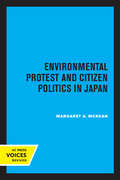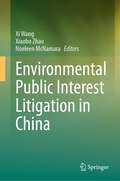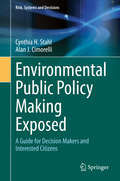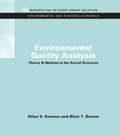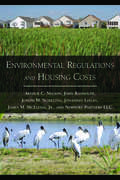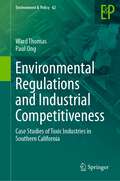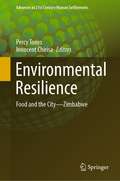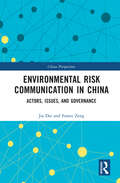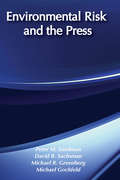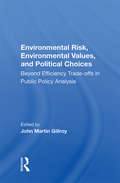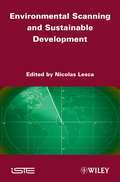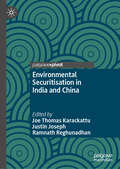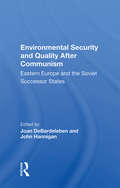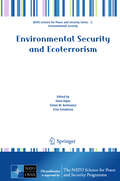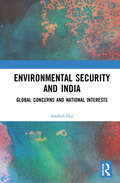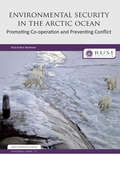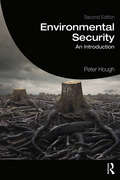- Table View
- List View
Environmental Protest and Citizen Politics in Japan
by Margaret McKeanThis title is part of UC Press's Voices Revived program, which commemorates University of California Press’s mission to seek out and cultivate the brightest minds and give them voice, reach, and impact. Drawing on a backlist dating to 1893, Voices Revived makes high-quality, peer-reviewed scholarship accessible once again using print-on-demand technology. This title was originally published in 1981.
Environmental Public Interest Litigation in China
by Xiaobo Zhao Xi Wang Noeleen McNamaraThis book offers readers an accessible and broad-ranging guide to Environmental Public Interest Litigation (EPIL), which has burgeoned in China over the past decade. The aim of this book is to provide a systematic review of Chinese experiences with EPIL in environmental matters, both with a view to gauging its success to date and well as discussing some more critical aspects. To this end, the book systematically examines the establishment and development of EPIL in China's legal, social, and political contexts. It examines particularly the significant role and functions of EPIL in China's environmental governance, and the far-reaching impacts on Chinese civil society and governments. It also offers readers an insiders' perspective in terms of procedural and substantive issues with respect to EPIL, by reviewing the institutional designs, theoretical underpinnings and specific mechanisms, the roles of various participants and stakeholders involved in this legal process. At the same time, it studies leading EPIL cases raised from environmental pollution, natural resource damage and ecological damage, and the effectiveness of environmental adjudication that sustains EPIL as a new form of judicial instrument. This book is written to remedy the gap between Chinese and English literature in this area of law. The analysis of these issues, through a historic and comparative perspective, reveals the strengths and weaknesses of the current legal regime and serves as a basis for recommendations for bringing about more effective EPIL in China.
Environmental Public Policy Making Exposed: A Guide for Decision Makers and Interested Citizens (Risk, Systems and Decisions)
by Cynthia H. Stahl Alan J. CimorelliThis book exposes the barriers to inclusive and effective public policy making, which are the current decision making paradigm and commonly held ideas that reduce public policy problems to scientific and technical ones. Through both environmental policy and other decision making examples, readers are shown the commonalities of all decision making. Solution-oriented practitioners and stakeholders will find this book filling a conceptual and methodological gap in existing policy literature and practice. The authors deftly guide readers from post-normal science, wicked problems, and uncertainty concepts to a conceptually-grounded, practical implementation of a new approach, the open solution approach. The Multi-criteria Integrated Resource Assessment (MIRA) is described as the first generation methodology that fulfills the expectations for the inclusive, transparent, and learning-based open solutions approach. MIRA is a holistic package of concepts, methods and analytical tools that is designed to assess Decision Uncertainty, the combined uncertainties that include data, problem formulation, expert judgments, and stakeholder opinions. Introduction of the Requisite Steps, the common steps found in all decision making, provides the yardstick for evaluating a variety of decision making processes, decision tools, and commonly found indices such as the Dow Jones Industrial Average or the Newsweek Green Ranking of corporations. The use of anecdotes, policy stories, and case examples makes this a very readable and practical book for citizens and experts. With this book, readers are prepared to critically evaluate these common indices for their personal use as well as challenge policy processes as a stakeholder. For policy practitioners, this guidebook will become a rubric to ensure an effective public policy making process and to critically evaluate decision support tools.
Environmental Quality Analysis: Theory & Method in the Social Sciences (RFF Environmental and Resource Economics Set)
by Blair T. Bower Allen V. KneeseThis book brings together state-of-the-art papers describing comprehensive approaches to residuals management and emphasizes the need for interdisciplinary solutions to complex environmental problems. Originally published in 1972
Environmental Regime Effectiveness: Confronting Theory with Evidence
by Edward L. Miles Arild Underdal Steinar Andresen Jorgen Wettestad Jon Birger Skjaerseth Elaine M. CarlinThis book examines why some international environmental regimes succeed while others fail. Confronting theory with evidence, and combining qualitative and quantitative analysis, it compares fourteen case studies of international regimes.
Environmental Regulation and the History of Capitalism: The Role of Business from Stockholm 1972 to the Climate Crisis (Routledge International Studies in Business History)
by Sandra Bott Janick Marina Schaufelbuehl Sabine PitteloudThis edited collection examines the historical role of business actors in climate and environmental governance since the 1970s. Through a compilation of recent, evidence-based historical research, this book unveils the origins of contemporary challenges in regulating environmental pollution. With original case studies, it offers a nuanced understanding of the environmental counter-offensive orchestrated by business leaders, associations, and think tanks post-1972, following the United Nations' pivotal Stockholm Conference on the Human Environment. Readers are presented with insights into the historical maneuvers of business entities aimed at mitigating regulatory risks, co-creating expertise, and framing the environmental debate. From revealing the tactics employed by various business actors to exploring the emergence of market-driven environmentalism, this volume offers a comprehensive exploration of the intricate dynamics shaping environmental policy. By contextualizing specificities and complexities, it enriches contemporary narratives on business influence and power dynamics within global capitalism. This book primarily caters to scholars across diverse historical disciplines, including business history, international relations, environmental history, and the history of capitalism. Additionally, it holds relevance for social scientists studying contemporary issues, policymakers grappling with environmental challenges, and those seeking a deeper understanding of the historical dimensions of climate governance.The Open Access version of this book, available at http://www.taylorfrancis.com, has been made available under a Creative Commons Attribution-Non Commercial-No Derivatives (CC BY-NC-ND) 4.0 license.
Environmental Regulation in Transforming Economies: The Case of Poland (Routledge Revivals)
by Helen Lawton-Smith Piotr JasinskiFirst published in 1999 , the book is based on papers given at the final workshop of a research project into the evolution of environmental regulation in Poland undertaken as part of the UKs ERSC Global Environmental Change Programme. Other invited papers focused on the development of regulatory policy in transforming economies and in the UK. Furthermore the book highlights the weakness of internal political processes in Poland and the important role played by foreign sponsored pressures whilst exsamaning the divergence between the way environmental charges are supposed to operate and the ways in which they are implemented and enforced. Topics covered include the links between privatisation and the environment, the saline water problem in Upper Silesia, enforcement of and compliance with environmental charges, air pollution in Krakow and the structure of the Polish environmental administration system.
Environmental Regulations and Housing Costs
by Jonathan Logan Arthur C. Nelson Llc Newport Partners Joseph M. Schilling James M. Mcelfish John RandolphMany communities across the nation still lack affordable housing. And many officials continue to claim that "affordable housing" is an oxymoron. Building inexpensively is impossible, they say, because there are too many regulations. Required environmental impact statements and habitat protection laws, they contend, drive up the costs of construction. But is this actually true? In a comprehensive study of the question, the authors of this eye-opening book separate fact from myth. With admirable clarity, they describe the policy debate from its beginning, review the economic theory, trace the evolution of development regulation, and summarize the major research on the topic. In addition, they offer their own research, accompanied by a case study of two strikingly different Washington, D.C., suburbs. They also include results of focus groups conducted in Dallas, Denver, and Tucson. The authors find that environmental regulatory costs--as a share of total costs and processes--are about the same now as they were thirty years ago, even though there are far more regulations today. They find, too, that environmental regulations may actually create benefits that could improve the value of housing. Although they conclude that regulations do not appear to drive up housing costs more now than in the past, they do offer recommendations of ways in which the processes associated with regulations--including review procedures--could be improved and could result in cost savings. Intended primarily for professionals who are involved in, or impacted by, regulations--from public officials, planners, and engineers to housing developers and community activists--this book will provide useful insights and data to anyone who wants to know if (and how) American housing can actually be made "affordable."
Environmental Regulations and Industrial Competitiveness: Case Studies of Toxic Industries in Southern California (Environment & Policy #62)
by Ward Thomas Paul OngWhile polluting industries in the U.S. continue to emit billions of pounds of toxic chemicals into the air, land and water every year, many economists and policy makers argue that environmental regulations stifle economic growth and reduce the standard of living for the American people. This book takes a fresh look at this question through three case studies of highly regulated polluting industries in the Southern California region: metal finishing, wood furniture, and dry cleaning. The case studies are based on a mix of qualitative and quantitative methods, including in-depth interviews with corporate managers and environmental regulators. The authors find that there is no universal pattern for predicting the effects of environmental regulations on industrial competitiveness, but that the outcomes depend on the structure of the industry being regulated, the design of the regulations, and the technologies that are available for compliance. The book is written in straight forward language that is accessible to the non-economist and will prove an essential resource for academics and students of all levels, and professionals and policy makers in the fields of environmental policy and regional economic development.
Environmental Resilience: Food and the City—Zimbabwe (Advances in 21st Century Human Settlements)
by Innocent Chirisa Percy ToriroThis book discusses the production, distribution, regulatory and management frameworks that affect food in urban settings. It plugs a gap in knowledge especially in the sub-Saharan Africa region where food, despite its critical importance, has been ignored as a ‘determinant of success’ in the planning and management of cities and towns. The various chapters in the book demonstrate how urban populations in Zimbabwe and elsewhere have often devised ways to produce own food to supplement on their incomes. Food is produced largely by way of urban agriculture or imported from the countryside and sold in both formal and informal stores and stalls. The book shows how in spite of the important space food occupies in the lives of all city residents, the planning and regulatory framework does not facilitate the better performance of food systems.
Environmental Risk Communication in China: Actors, Issues and Governance (China Perspectives)
by Jia Dai Fanxu ZengThe role of media is becoming increasingly important as globalization has developed. Given fast social transformation and technological development in China, the consequent environmental and health risks demand citizens integrate the communication and prevention of such risks as a significant part of their daily life. This book systematically discusses the communication process of typical environmental risk issues, and the complex interaction among multiple actors, including the public, media, experts, non-governmental organizations, and government in contemporary China. From a media-centered perspective, it applies major theories in the field of enviornmental and risk communication, and uses a variety of empirical research methods to unravel the complicated and unique experience of communication and governance. Combining theoretical reflections with real-life examples of Chinese scenarios, the authors not only encourage a dialogue between Western and Chinese academia but also inspire students and practitioners to apply risk communication theories to solving real-life problems. The book will appeal to students, scholars, and practitioners of risk and environmental communication studies.
Environmental Risk and the Press
by Peter M. SandmanToxic spills, acid rain, poor air quality-scarcely a day goes by without a report in the press on an environmental risk issue. Nowhere is this more prevalent than in New Jersey, a leading state in the production of chemicals, and the state with the largest number of Superfund cleanup sites. How accurate and how extensive is environmental risk reporting in the New Jersey press, and what can be done to improve the quality of its coverage of environmental risk? And what can we learn from the New Jersey experience?Environmental Risk and the Press sets out to answer these questions. The authors explore the strengths and weaknesses of environmental risk reporting in New Jersey by evaluating the state's best environmental risk stories. They find that even the best stories have a number of problems, and they develop a number of concrete recommendations for reporters and editors on how to improve their coverage in this area.The authors also investigate the feasibility of various methods for getting environmental risk information to reporters and into their newspapers. They recommend three ways to improve the quality of environmental risk information available to journalists. The first is nationwide distribution of environmental press kits that include a directory of news sources, a glossary of technical terms, and briefings by experts on strategies for covering particular types of environmental risk situations. The second is continuing education programs on environmental risk for reporters and editors. The third is creating collections of relevant reference books in the offices of newspapers and broadcast stations. The authors report on initial actions taken to implement these recommendations, and plans for others. They conclude that the broader availability of environmental risk information to the media will result in better reporting of environmental problems. This book is a first step toward enhancing journalists' appreciation of the importance of risk as an issue in environmental news coverage, and providing them with the tools to help them act upon that heightened awareness.
Environmental Risk, Environmental Values, And Political Choices: Beyond Efficiency Tradeoffs In Public Policy Analysis
by John Martin GillroyPublic decisions on environmental risk have traditionally been weighed in terms of the principle of efficiency and its methodologies, such as cost-benefit analysis. These original essays argue for moving beyond the market paradigm toward making policy that incorporates environmental values.
Environmental Scanning and Sustainable Development
by Nicolas LescaThis work is an initial exploration of the relationship between scanning and sustainable development. In ten chapters, the authors examine the application, characteristics and implementation of scanning oriented toward sustainable development. Thus the work offers some answers to the questions “what is sustainable scanning?”, “what new issues does it raise for management practice and management science?”, “what forms can it take?” and “how…?”
Environmental Securitisation in India and China
by Joe Thomas Karackattu Ramnath Reghunadhan Justin JosephThis book examines how emerging environmental challenges are situated within existing International Relations (IR) theoretical understandings of &‘security&’. As governments in the Global South undertake policy interventions to mitigate the impact of increasing climatic changes and yearn to achieve human-nature harmony, one can observe similar patterns of responses chiefly due to the ecology-economy dichotomy in these states and their societies. In this context, it brings to the readers various aspects of the theory and practice of state interventions in the form of environmental securitisation in the Global South majorly under four themes (encompassing theory and policy processes). Chapters in this volume explicate connections between the environment and International Relations Theory, securitisation in developing countries, state society and the environment in India and China and lastly, public participation and environmental policymaking. It presents a comprehensive and coherent overview of the politics of securitisation in India and China, two prominent economies in the Global South. Faculty and researchers who work on non-western International Relations theory and non-traditional security threats, policy practitioners and experts in environmental policymaking, and students of IR and Comparative Politics, chiefly, will benefit from this book.
Environmental Security And Quality After Communism: Eastern Europe And The Soviet Successor States
by John Hannigan Joan DeBardelebenThis volume, based on papers presented at a conference on Environmental Security after Communism at Carleton University, explores the linkages between environmental quality and security in Eastern Europe and the Soviet successor states.
Environmental Security and Ecoterrorism
by Hami Alpas Simon M. Berkowicz Irina ErmakovaIn recent years, the concept of environmental security has been adapted to include preparedness for acts of ecoterrorism. This latter term has now become synonymous with environmental terrorism where the perpetrator uses the environment as a weapon to harm an opponent. The intended outcome is usually large-scale deaths, severe damage to the environment, and instilling fear in the general population. This book explores various facets of ecoterrorism including the role of the state in pursuing and maintaining environmental security, a review of the concept of ecoterrorism, food security challenges and weaknesses, technological countermeasures to enable rapid detection or response, and existing pollution sources and hazards that may serve as targets for terrorist acts. In sum, this volume provides a useful overview for both the layperson and experienced researchers.
Environmental Security and India: Global Concerns and National Interests
by Satabdi DasThis book examines environmental issues through the lens of security studies and presents a comprehensive analysis of Indian policy in dealing with threats posed by climate change. This volume, • Puts forward theoretical base for securitization of environmental issues, incorporating different schools of thought; • Presents a survey of global environmental politics in general and the effects of climate change and its consequences for India's national security in particular; • Examines the politics involved in India's environmental policy at both the domestic and international level; • Outlines key policy takeaways and possibilities for action that can help contain the threat of environmental change. A comprehensive guide to a new and emerging dimension in Indian security policy, this book will be essential reading for students and researchers of international relations, security studies, especially non-traditional security, public policy, especially environmental policy, and area studies.
Environmental Security in Latin America
by Gavin O'TooleThis book examines security in Latin America through an environmental lens, at a time when this region faces a broad and growing spectrum of threats. The book considers the backdrop against which security debates about Latin America have been conducted; the extent to which scholarship has been dominated by traditional US strategic concerns; and how, in the changing context at the end of the Cold War, some policymakers within Latin America itself at both national and regional levels began to reposition security. It argues that traditional security scholarship focusing on military defence and strategic affairs in this region is hard to explain and out of date, and offers reasons why a new focus on environmental threats within a broader human security perspective has much to offer this field. Such a focus is justified by the scale of the challenges that environmental degradation is posing in Latin America, and the very real impact of climate change there. The book considers how the various theoretical possibilities of the term ‘environmental security’ all have some potential application to this region, where the natural environment is rapidly being securitized by military forces on behalf of their states. Finally, it proposes that a fruitful approach to Latin America might be one where human and environmental security have parity. This book will be of interest to students of environmental security, Latin American security, human geography and IR in general.
Environmental Security in the Anthropocene: Assessing Theory and Practice (Critical Security Series)
by Judith Nora HardtThis book provides a critical assessment of the theories and practice of environmental security in the context of the Anthropocene. The work analyses the intellectual foundations, the evolution and different interpretations, strengths and potential of the link between environment and security, but also its weaknesses, incoherencies and distortions. To do so, it employs a critical environmental security studies analytical framework and uniquely places this analysis within the context of the Anthropocene. Furthermore, the book examines the practice–theory divide, and the political implementation of the environmental security concept in response to global environmental change and in relation to different actors. It pays significant attention to the Environment and Security Initiative (ENVSEC), which is led by different programs of the United Nations, the OSCE and until recently by the North Atlantic Treaty Organization (NATO), among others, and has largely been overlooked in the academic literature to date. The goal is to study how environmental security practice could inform and shape the environmental security theory, and also to explore how, conversely, new theoretical insights could contribute to the enhancement of environmental security activities. This book will be of great interest to students and academic scholars of Environmental Security, Critical Security Studies, Green Political Theory, Global Governance and International Relations in general.
Environmental Security in the Arctic Ocean: Promoting Co-operation and Preventing Conflict (Whitehall Papers)
by Paul Arthur BerkmanThe North Pole is being transformed from a sea-ice cap to a seasonally ice-free sea within the next few decades. This fundamental shift in the boundary conditions of the Arctic Ocean will create a new natural system with different dynamics than anything previously experienced by humans in the region. With the diminishing ice cover, interests are awakening globally to take advantage of extensive energy, shipping, fishing and tourism prospects in the Arctic Ocean. A range of states, including the major Arctic powers, are increasingly asserting their sovereignty seawards. National security policies are being declared and nuclear-capable states are adjusting their strategic deployments in the Arctic Ocean. There are forums for international cooperation in the Arctic, most notably the Arctic Council, but peace in the Arctic Ocean has yet to be explicitly established as a common interest because of the long-standing military presence. Risks of political, economic and cultural instabilities are inherent consequences. This volume proposes environmental security as providing a holistic framework to assess these security risks and then identify the appropriate adaptation and mitigation responses. Only after shared risk assessment and understanding of the appropriate responses, will there be sufficient clarity about the governance paths to pursue within the international legal framework of the law of the sea.
Environmental Security in the Asia-Pacific
by Iain Watson Chandra Lal PandeyEnvironmental security has been one of the greatest threats of the twenty-first century. Crossing the tipping point of two degrees Celsius is projected to be catastrophic, but perennial policy gridlock at the United Nations' multilateral climate change negotiations has so far prevented significant progress. The Asia-Pacific region has much at stake in these negotiations—it is often regarded as the most climate-vulnerable region in the world and also harbors the largest number of poorpeople already affected and in danger of being affected by climate change. Existing climate change literature frames issues through the prism of North-South relations. In contrast, this book focuses on both North-South and South-South relations to reveal an understanding of major climate change and climate change management issues through practices and narratives of environmental security in a specific regional context. The case studies are diverse and represent both large emitters like China and India and the smallest emitter, Nepal, as well as resource-cursed Indonesia, dilemmatic New Zealand, and green visionaries Korea and Japan. Contributors analyze causal interlinkages that affect environmental security policy from both geopolitical and geoeconomic dynamics.
Environmental Security: An Introduction
by Peter HoughThis student-friendly textbook offers a survey of the competing conceptions and applications of the increasingly prominent notion of environmental security. The book is divided into three sections. In the first, the key theoretical and practical arguments for and against bringing together environmental and security issues are set out. The book then goes on to present how and why environmental issues have come to be framed in some quarters as ‘national security‘ concerns in the context of the effects of overpopulation, resource depletion, climate change and the role of the military as both a cause and a solution to problems of pollution and natural disasters. Finally, the third section explores the case for treating the key issues of environmental change as matters of human security. Overall, the book will provide a clear, systematic and thorough overview of all dimensions of an area of great academic and ‘real-world’ political interest but one that has rarely been set out in an accessible textbook format hitherto. This book will be essential reading for students of environmental studies, critical and human security, global governance, development studies, and IR in general.
Environmental Security: An Introduction
by Peter HoughThis textbook offers a student-friendly survey of the global politics of the environment through the prism of security studies. This book is divided into three thematic sections. The first part sets out the key theoretical and practical arguments for and against bringing together environmental and security issues. The second part examines why environmental issues have been framed by some as ‘national security‘ concerns in the context of the effects of overpopulation, resource depletion, climate change and the role of the military as both a cause and a solution to problems of pollution and natural disasters. Finally, the third section explores the case for treating the key issues of environmental change as matters of human security. The chapters have been updated to include the 2015 Paris Climate Change Accords, the Trump and Sendai Framework for Disaster Risk Reduction, and there is a new chapter on environmental history. Overall, the book provides a clear, systematic and thorough overview of an area of great academic and ‘real-world’ political interest. This book will be essential reading for students of environmental studies, critical and human security, human geography, development studies, and International Relations in general.
Environmental Security: Approaches and Issues
by Rita Floyd Richard MatthewEconomic development, population growth and poor resource management have combined to alter the planet’s natural environment in dramatic and alarming ways. For over twenty years, considerable research and debate have focused on clarifying or disputing linkages between various forms of environmental change and various understandings of security. At one extreme lie sceptics who contend that the linkages are weak or even non-existent; they are simply attempts to harness the resources of the security arena to an environmental agenda. At the other extreme lie those who believe that these linkages may be the most important drivers of security in the 21st century; indeed, the very future of humankind may be at stake. This book brings together contributions from a range of disciplines to present a critical and comprehensive overview of the research and debate linking environmental factors to security. It provides a framework for representing and understanding key areas of intellectual convergence and disagreement, clarifying achievements of the research as well as identifying its weaknesses and gaps. Part I explores the various ways environmental change and security have been linked, and provides principal critiques of this linkage. Part II explores the linkage through analysis of key issue areas such as climate change, energy, water, food, population, and development. Finally, the book concludes with a discussion of the value of this subfield of security studies, and with some ideas about the questions it might profitably address in the future. This volume is the first to provide a comprehensive overview of the field. With contributions from around the world, it combines established and emerging scholars to offer a platform for the next wave of research and policy activity. It is invaluable for both students and practitioners interested in international relations, environment studies and human geography.
